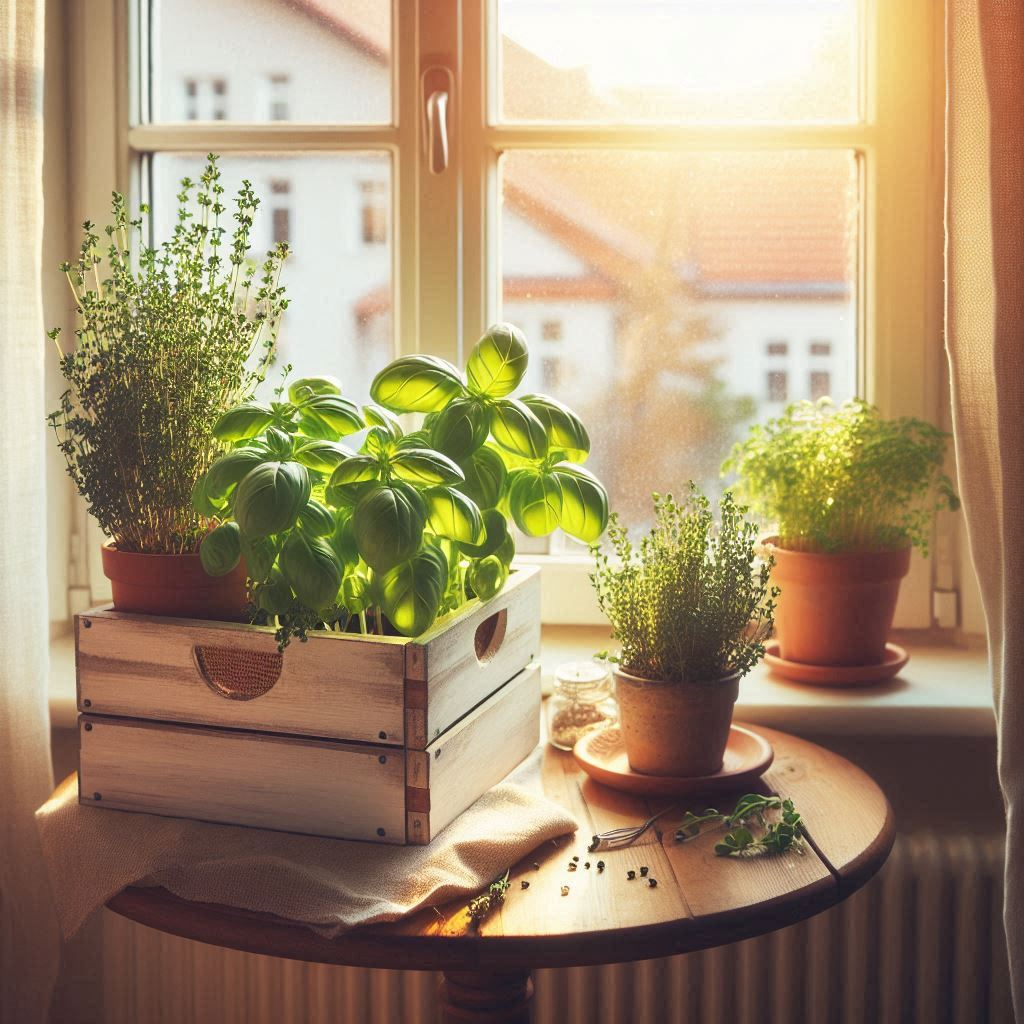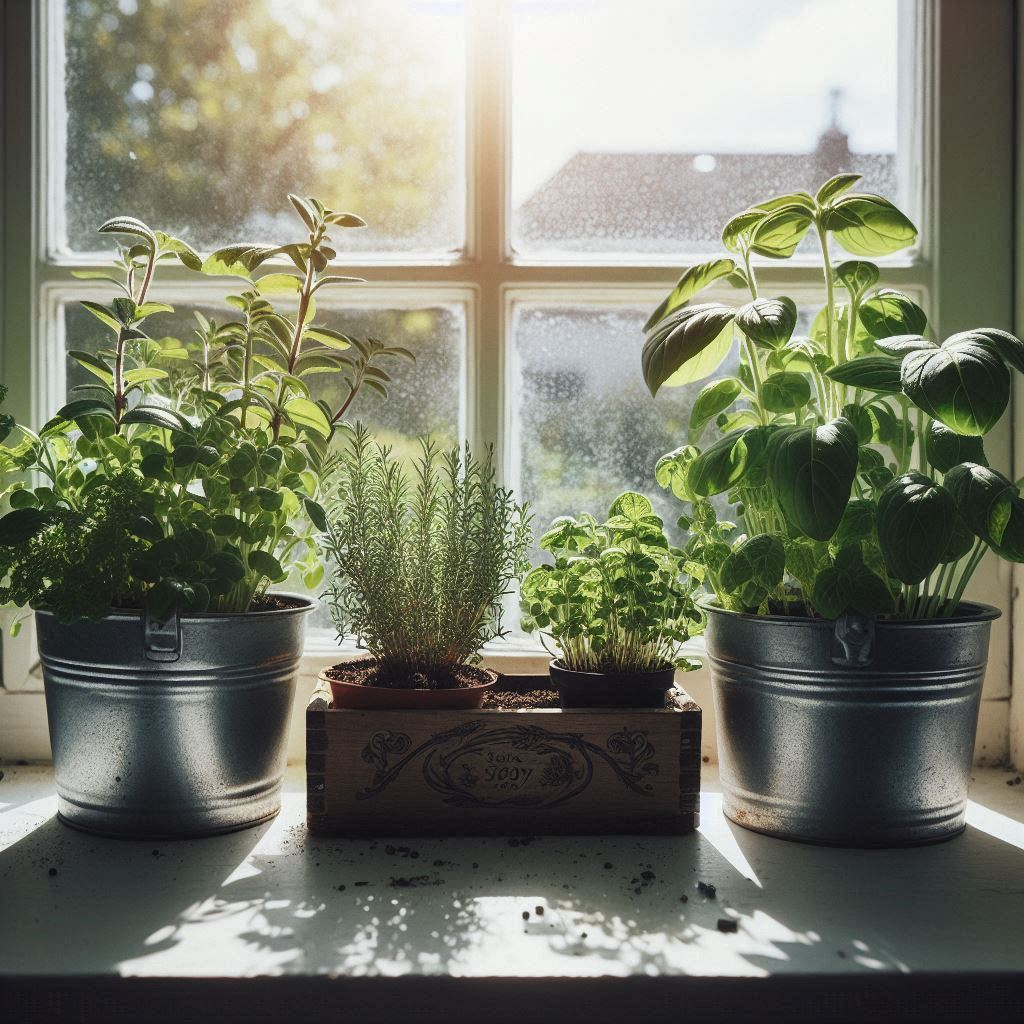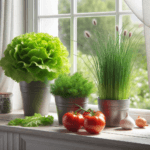
Growing an indoor herb garden is a great way to enjoy fresh herbs all year long, and there’s no waiting until they’re in season. The freshest herbs are at your fingertips anytime you want.
Anyone can grow a productive indoor herb garden. You don’t need much experience, just a little time and some TLC. With the proper materials and care it’s a win-win. You have access to tasty and healthy herbs at all times. As an added bonus growing herbs indoors adds color and fragrance to your home and it will save you a few coins at the supermarket to boot.
Rule #1 – All herbs love the sunshine.
Find a sunny window! If you can’t find a window that doesn’t give you 6 or more hour of sun shining through it consider LED grow lights to supplement the lack of sunlight time.
Next, decide which herbs you want to grow.
Get to know each individual plants needs. This will help with proper maintenance, watering and feeding of your different types of herbs.
Although some herbs don’t do quite as well as others when grown indoors, there are many more that do very well when grown in containers indoors.
I’ve grown Basil, Parsley, Thyme, Rosemary and Oregano indoors, all with great results. Rosemary is a little touchy in climates with lower humidity. Rosemary can also grow quite large. I didn’t list Rosemary but Rosemary does grow well inside and is also aromatic.
If you lack window space but do have some extra space in your home, consider purchasing a grow lamp. The lamps I use make it very easy to expand coverage with a daisy chain addition of more lamps. An unused closet is a perfect place to grow herbs and vegetables. Grow your plants under the lights at a distance of 5 or 6 inches (12.5-15 cm.) minimum and 15 inches (38 cm.) maximum
I did a little research and found a few herbs that have been proven to grow well indoors and picked out some of my personal favorites. It is just a small sample and there are many more herbs that do well when grown indoors.
So, in no particular order, let’s get growing.
Parsley
Parsley is a biennial. There are two varieties of Parsley.
P. crispum (Curly-leaf parsley), is sometime considered ornamental due to the mild flavor.
P. crispum neopolitanum (Flat-leaf parsley), is more valued as it imparts a stronger flavor to your cuisine and chosen by chefs worldwide.
Parsley is used in Middle Eastern, European and American cuisine.
- Use a good soil and ensure that there is good drainage, but not to the point that water flows right through. Try to keep your soil evenly moist. Always use a high-quality soil. Parsley needs very little fertilization.
- Parsley will grow to be 9-12 inches tall and wide.
- If growing year-round try to find a West facing window during the winter.
Thyme
Thyme is a perennial.
Not all varieties of Thyme are used to spice up your meal. A variety of Thyme is grown for ground cover and another is grown for its bright flowers.
Thyme is a wonderful flavoring for many dishes, as well as many different of types of meat.
Drying and storing your trimmings for use when needed later saves money and insures a steady supply.
Thyme prefers low humidity. Kitchen humidity usually higher, so skip that windowsill if possible. Try to find a place in a drier room to grow your Thyme, preferably with lots of sunshine. Don’t use a lots of water as Thyme is a drought-resistant plant and overwatering may cause harm.
- Plant Thyme in good soil, and make sure the soil drains quickly. Like Parsley Thyme also requires little fertilization.
- Thyme grows to be 6-12 inches tall and wide.
- For year-round growing find a window facing South during the winter.
Basil
Basil is an annual and is a must around my home.
Every year we can tomato sauce and will always add 2 or 3 freshly picked Basil leaves into each jar prior to sealing them up.
Bonus features, Basil is aromatic and attractive.
Italian Sweet Basil is my go-to but certainly not the only Basil out there. Some types have purple foliage for example.
To keep your Basil growing you will need to begin to pinch off the emerging blossoms once the plant has reached about 6 inches tall. This will prevent the plant from blooming and going to seed.
Basil needs some room in the pot to grow, also good ventilation is helpful.
- Plant in good soil and ensure good drainage, but like Parsley, not to the point that water flows right through. Try to keep the moisture in the soil even throughout. Use a high-quality soil. Basil will need to be fertilized on occasion, about every other week, an All-Purpose fertilizer will work fine.
- Basil will grow to 18-24 inches tall and wide
- For year-round growing find a window facing South during the winter.
Oregano
Oregano is a drought-resistant perennial and is also very easy to grow indoors.
Oregano is the go-to seasoning for a variety of Italian dishes.
Oregano oil extract is commonly used for medicinal purposes. Extracting the oil is not difficult and can be done at home on the stove.
Oregano does best with six to eight hours of sun. If possible, find a southern facing window.
Oregano also does best in a drier soil, so let the soil dry out some between waterings.
To produce more leaves and keep the plant more compact, trim your oregano regularly. You can dry the trimmings.
Oregano requires some fertilization. Use a water-soluble all-purpose fertilizer and apply every other week.
Oregano is hardy and can thrive in lower humidity, but a little extra humidity doesn’t hurt. If you want to raise the humidity some, place the pot on a tray of moistened pebbles.
- Plant in good soil and insure good drainage. Oregano needs little watering.
- Oregano will grow up to 2 feet tall and 18 inches wide
- For all year growth find a south-facing window if possible. Oregano loves the sun.
Sage
Sage is a perennial and related to the Salvia.
Sage is renowned for its use with poultry, especially in stuffing.
There is an ornamental variety of Sage, with a tri-color foliage.
Like Oregano, Sage doesn’t need a lot of water and like most herbs, Sage loves the sun.
Although sometimes associated with mystical practices, burning Sage is actually healthy for you. The most frequently used types of Sage have antimicrobial properties, meaning they will help control infectious bacteria, viruses, and fungi.
Plus, studies have shown that Sage works to repel insects.
- Plant in good soil and insure good fast drainage. Sage needs little watering, be sure not to overwater your plant. Sage also needs little fertilization.
- Sage will grow up to 2-2.5 feet tall and 2-3 feet wide
- For all year growth find a south-facing window if possible. Sage loves sunshine.
Chives
Chives are a perennial and are related to onions with a mild onion flavor.
Chives are very easy to grow.
Chives go well in soups, salads and as a garnish.
Chives are sometimes grown for their flowers which are attractive when dried and are often used in flower arrangements.
Chives need six to eight hours of sunlight when growing inside.
Chives will multiply. You can divide them once a nice sized clump has developed. To do this dig underneath where you’ll find small bulbs and a dense root mass. Simply break off a clump of 3 to 5 plants and transplant it to another pot.
Water your Chives when the soil is dry to the touch on top.
Low-dose fertilization is recommended for indoor Chives. Apply a water-soluble fertilizer at half strength every other week. Stronger doses of fertilizer tend to weaken the taste.
Place the pot on a tray of moistened pebbles to bring the humidity up, chives do like some humidity.
- Use a quality soil, rich in organic matter. Keep well-drained..
- Chives will grow to 10-15 inches tall and wide
- If growing all year long try to find a West facing window during the winter.
Cilantro
Cilantro is an annual.
Cilantro grows very fast
Cilantro will become bitter once it flowers. Pinch the emerging flowers off to prolong the life of your plant.
Because Cilantro is not a year-round plant, I will plant a new Cilantro every month or so. This way there is always a fresh plant to pick from.
Cilantro is used in recipes worldwide and is often paired with lime and butter. Cilantro is a must for salsas and is a wonderful addition to dips, sauces, and pesto.
To help hold moisture, plant your Cilantro in a little deeper plastic pot, about 12 inches deep and 18 inches wide.
- Use a good quality acidic soil. Good drainage. Try to keep soil evenly moist.
- Cilantro will grow 1-2 feet tall and 1–1.5 feet wide
- Find a bright east facing spot with access to the morning sun.
Conclusion
These are some of the more common herbs. However, this is just a small sample of the herbs that do well when grown indoors.
My main criteria for picking the herbs I intend to grow is simple, grow the herbs I love in my meals.
Here’s another thing to keep this in mind, because there are different watering and care needs for each type of herb plant you choose. It’s best if you don’t mix and match your herbs in one pot. Keep them separated by type and grow them in their own pots.
Always use an indoor potting mix. These soils have been formulated to contain the nutrients and minerals your plants need to compensate for not being grown in the earth.
If you take the time and provide proper care and feeding you will have an herb garden to be proud of.
Happy growing!




